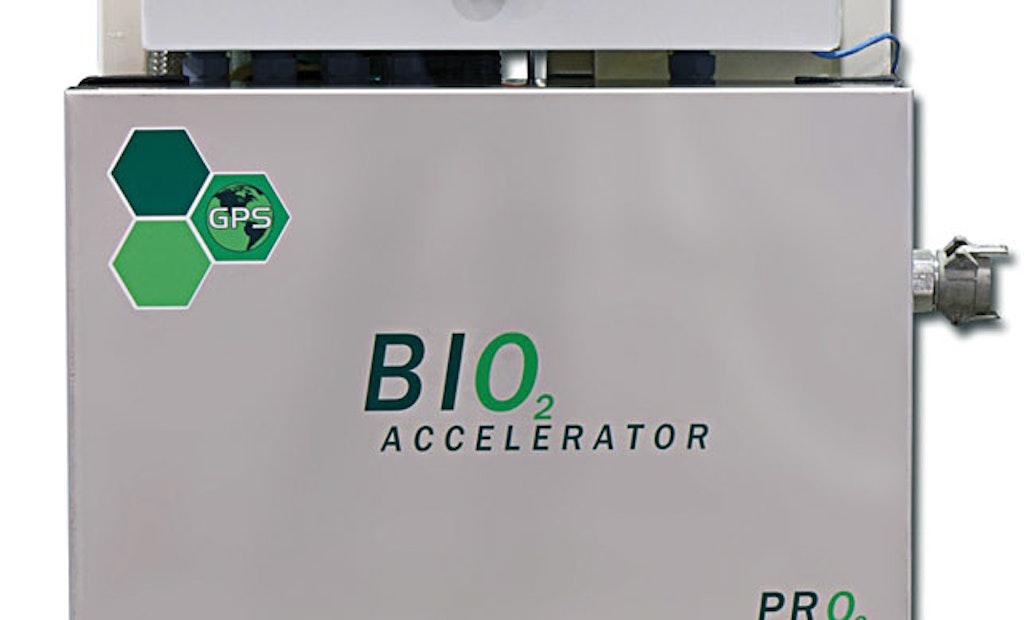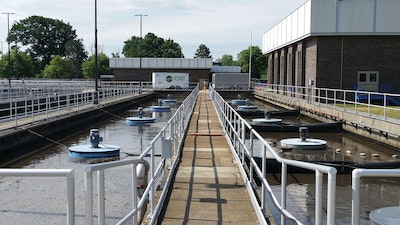
Interested in Blowers?
Get Blowers articles, news and videos right in your inbox! Sign up now.
Blowers + Get AlertsAeration is the most energy-intensive and costly process in wastewater treatment plants. Engineers and operators constantly look for ways to make it more efficient.
One advance was the replacement of coarse-bubble aerators with fine-bubble units. More bubbles mean more surface area through which oxygen can enter the wastewater. Now, Greener Planet Systems offers a new approach that comes close to the ultimate in aeration efficiency.
Instead of using bubbles, which ultimately float to the surface and disperse into the air, the PrO2 unit introduces oxygen mostly in molecular form. This means nearly all of the oxygen remains in the water to help bacteria do the work of breaking down waste. As a result, aeration requires significantly less energy than in conventional treatment systems.
The unit is produced by Blissfield Manufacturing; Greener Planet Systems is the master distributor for the technology. Glen Burkhardt, P.E., provides process engineering and technical input on applications of the product. He talked about the technology in an interview with Treatment Plant Operator, along with Chip Tokar, representing Natural Resources Management, a registered dealer also involved in scientific evaluations of the product.
TPO: Where did this technology originate?
Tokar: It was originally developed for medical applications to deliver blood super-saturated with oxygen for heart and organ transplants and other major medical procedures. Blissfield, as the manufacturer, took on licensing for nonmedical applications and contracted with Greener Planet Systems as the master distributor. We’re just starting to introduce the PrO2 to the wastewater treatment market.
TPO: What is the rationale for offering this product to wastewater treatment facilities?
Tokar: We’ve taken the old aeration technology using bubbles and exponentially increased efficiency by delivering the oxygen in a molecular state, without bubbles. That reduces energy consumption by delivering oxygen at a much smaller horsepower than what it takes with a standard fine-bubble diffuser.
Burkhardt: We have found that with the PrO2, we can achieve comparable treatment performance with only 20 percent of the oxygen delivered by fine-bubble air diffusion. The efficiency of oxygen transfer into the water is almost 100 percent because it is in the molecular state and not in bubbles. With conventional aeration you’re trying to strip some oxygen out of the bubbles while they are rising and ultimately escaping at the surface.
TPO: What are the basic components of this technology?
Tokar: Four things needed. One of course is the PrO2 unit itself. In order for the unit to operate, we need an oxygen source, which typically is a liquid oxygen tank or an oxygen generator. Then we need electricity. Our smaller machines can operate on 110 volts, and we can scale them up to where they require 220 volts. We also need a slipstream source, typically clean water, although it can be the wastewater we’re treating, in which case we need to add a filter to clean the water of suspended solids before it enters the machine.
TPO: Once all that is in place, how does the unit do its work?
Tokar: The slipstream enters the machine, and the oxygen from the tank or generator is injected into it. The oxygen essentially saturates the slipstream at approximately an 80 percent molecular level. The remaining 20 percent of the oxygen is in very tiny bubbles — what we call nanobubbles. Then the slipstream runs through piping into the target area, which is an aeration basin or an aerobic digester.
TPO: Which type of application is more common?
Tokar: At this time, we are more effective treating sludge, injecting oxygen onto a digester. However, in a test installation in Genesee County, Michigan, we injected into the aeration basin because we wanted to generate efficiency numbers.
TPO: What makes it possible to introduce the oxygen in molecular form?
Burkhardt: We inject the oxygen under pressure. Henry’s Law of physics says that increasing the pressure increases the ability of a liquid to dissolve oxygen. We operate at about 300 psi, and that enables us to introduce nearly all of the oxygen in the molecular state.
TPO: Is there a sweet spot in terms of the type or size of facility where this technology is the most applicable?
Burkhardt: It could apply to nearly any-size facility. On the sludge processing side, it probably has wider application because we’re able to achieve higher volatile solids reduction and a better recycle stream quality, and we can substantially reduce the volume of material that needs to be handled. On the aeration side, it has the most potential where a new plant or an addition to a plant is being constructed. However, where a community is looking to expand capacity, we learned at Genesee County that we could process 25 to 30 percent more wastewater through the same aeration tank volume by using the PrO2, as opposed to fine-bubble aeration.
TPO: Can you provide an example of how this technology has been deployed in a digester aeration application?
Burkhardt: A 4.5 mgd facility in Apopka, Florida, is using the technology in a 350,000-gallon sludge tank. They are adding oxygen from the PrO2 subsurface without providing any mechanical mixing of the solids. They’re finding that the molecular oxygen diffuses itself throughout the tank. It’s a unique approach to aerobic digestion because it’s not necessary to mix the tank contents to increase the biological activity that consumes the volatile solids. They used to haul seven loads of biosolids per week; they are down to two loads since they started using the PrO2. It’s a very low-energy application. They have 3 hp connected, whereas a tank that size using fine-bubble aeration would probably require 75 hp.
TPO: What has been the response to this technology in the marketplace?
Tokar: The challenge is to explain the difference between introducing molecular oxygen versus fine-bubble aeration. Once operators see it in operation, the benefits it can offer become very obvious. It’s about “show me” in this business.






